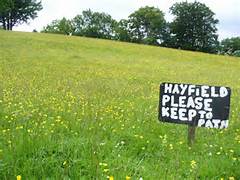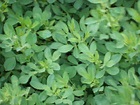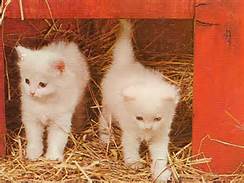The mon th of May brings on the opportunity to harvest the first cutting of a hay meadow. There are many different kinds of hay that we grow. Legumes may be an alfalfa or a clover. Grasses many times include orchard grass, timothy, brome grass, rye grass or endophyte free fescues.
th of May brings on the opportunity to harvest the first cutting of a hay meadow. There are many different kinds of hay that we grow. Legumes may be an alfalfa or a clover. Grasses many times include orchard grass, timothy, brome grass, rye grass or endophyte free fescues.
Fertility is always important in raising a good crop. Legumes and grasses both will need potash (K) and phosphorus (P) for proper growth. Grasses only need nitrogen (N) as legumes produce their own naturally. Summer and fall application of P & K are most efficient and N applications for grass meadows are best done as soon as fields permit in spring, keeping in mind to be as close to 30-45 days before the first harvest as you can. Every spring is somewhat different in weather and ground conditions so this does vary somewhat. The pure stands of grasses will need N applications right after harvesting each cutting to allow for maximum growth, quality and yield.
Alfalfa is a great crop by itself or in a mixture with a grass or grasses, clover the same. Orchard grass, timothy, rye grass and modern endophyte free fescue can do well alone or in a mixture with alfalfa or clover. Brome grasses are usually found in mixtures with other grasse s or legumes. Just remember when grasses are in a meadow as a stand-alone crop you will need N for profitable results. Legume/grass mixtures can make for great meadows when matched with the right grasses and percentages of each for your specific needs. In a 5-20 percent mixture of grass with the remainder in legumes, these meadows usually produce sufficient nitrogen naturally from the legumes for the grasses to utilize.
s or legumes. Just remember when grasses are in a meadow as a stand-alone crop you will need N for profitable results. Legume/grass mixtures can make for great meadows when matched with the right grasses and percentages of each for your specific needs. In a 5-20 percent mixture of grass with the remainder in legumes, these meadows usually produce sufficient nitrogen naturally from the legumes for the grasses to utilize.
The species of animal you are feeding or grazing will ultimately drive your decision as to what kind/kinds of hay to plant in your meadows. Producing quality hay is determined by a number of different factors, some we can manage and some we cannot……
The ones we can;
Fertility
Drainage
Weed control
Protection from insect predators
Proper equipment
Equipment maintenance, proper adjustments and preparation
Labor
Storage
Timeliness of cuttings (weather is a factor)
The ones we can’t;
WEATHER!!!
Heat
Humidity
Sun
Clouds
Wind
Moisture…too little or too much!!
How big of a window of opportunity we have to harvest.
So as the hay season begins to unfold, the opportunity to harvest another valuable crop over the next several months lies ahead. Enjoy the different stages of the crop and the wildlife and nature that you find in those meado ws that God has blessed us with. Good luck and may your barns be blessed with over flowing mows of quality hay!!
ws that God has blessed us with. Good luck and may your barns be blessed with over flowing mows of quality hay!!